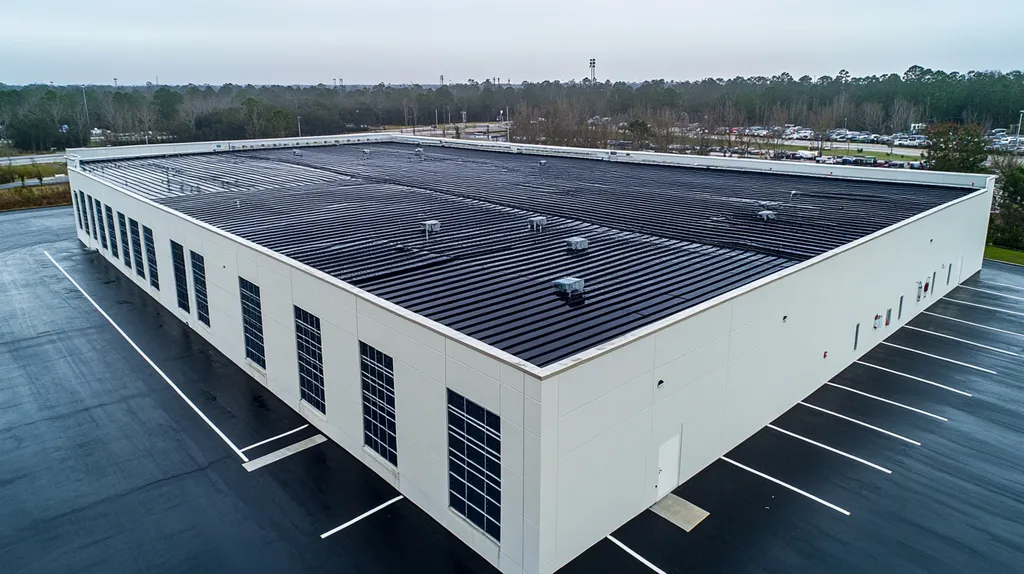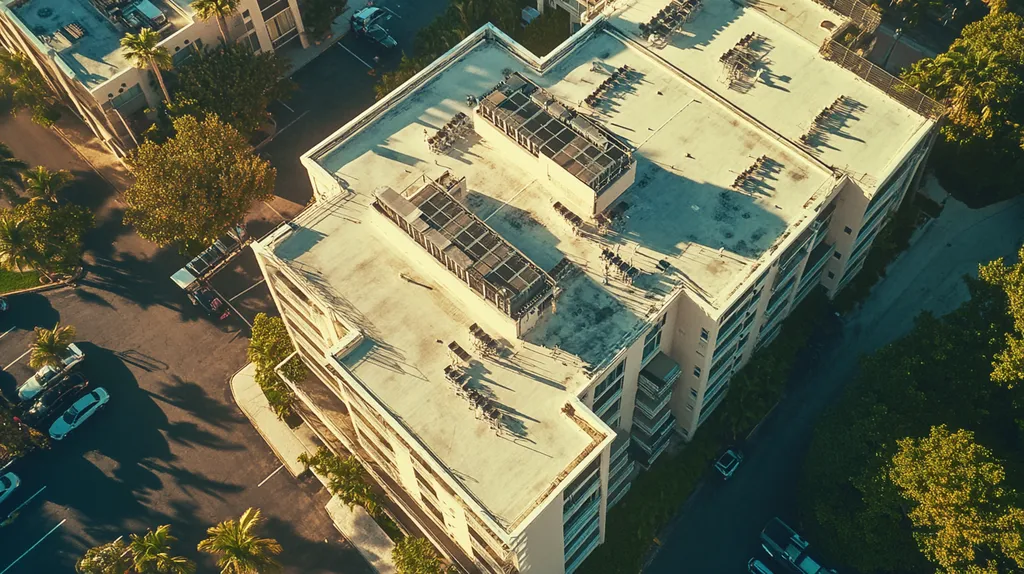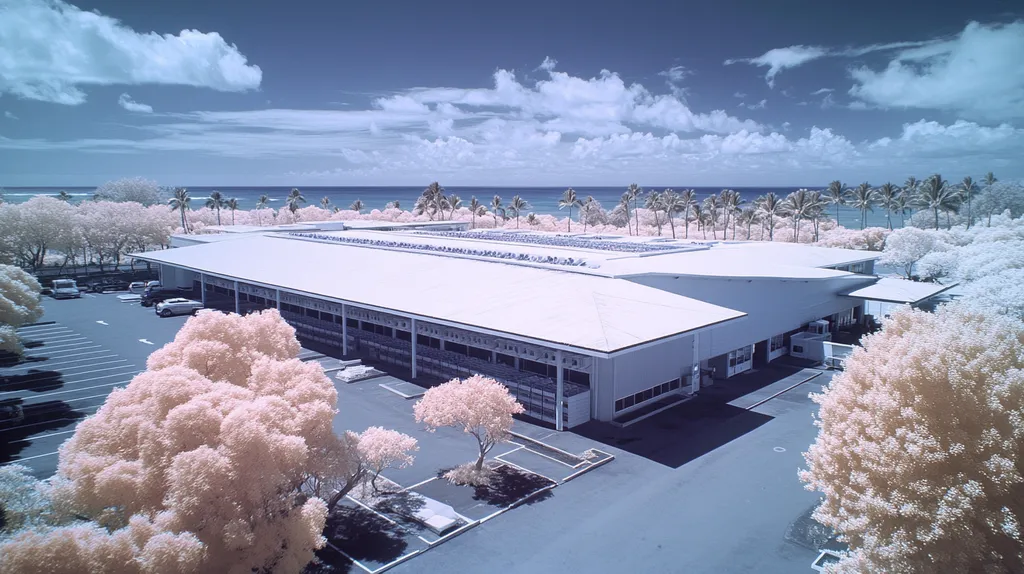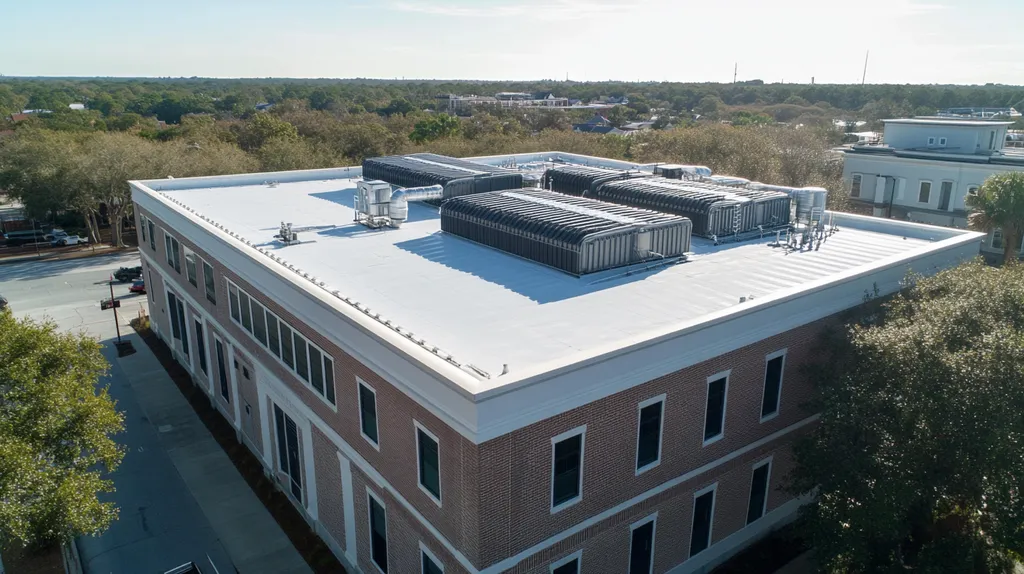Industrial facilities across North America waste an estimated $3.3 billion annually due to inadequate roof thermal performance, with over 60% of buildings relying on outdated evaluation metrics that fail to capture real-world conditions.
As energy costs continue to surge, the limitations of traditional thermal performance measurements have become impossible to ignore.
Current industry standards, particularly the focus on R-Value and static testing conditions, systematically underestimate the complex dynamics of heat transfer and energy efficiency in commercial roofing systems.
This analysis challenges established thermal performance metrics while presenting evidence-based alternatives that better reflect actual coating behavior under diverse environmental conditions.
SECTION 1: CURRENT PRACTICES
The thermal performance of industrial roof coatings is a critical concern for property owners and facility managers, especially as energy expenses continue to soar. The effectiveness of thermal management systems has never been more essential. Current methods, particularly traditional R-Value metrics, often fail to capture the intricate realities of real-world conditions. This section delves into established practices, shining a light on their shortcomings in evaluating true thermal performance.
R-Value as the Standard Metric
R-Value has served as the long-standing benchmark for measuring thermal resistance in various building materials, including roof coatings. While this metric is straightforward, it neglects numerous factors that impact thermal performance. For instance, R-Value does not account for key elements like humidity, air infiltration, or the angle of sunlight—all of which play a vital role in determining how effective a coating can be.
Moreover, relying solely on R-Value can create a distorted view of performance in real-world scenarios. A coating boasting a high R-Value may struggle in extreme weather, ultimately compromising energy efficiency. This emphasis on initial R-Value can also steer property owners toward cheap solutions, neglecting long-term energy savings that might be more advantageous.
As a result, many facility managers find themselves facing a dilemma. They require roofing solutions that genuinely optimize performance and lower energy costs but are often stuck with outdated metrics. This dependency on R-Value can result in costly errors and decisions, underlining the urgent need for a more robust, multifaceted assessment method.
In essence, while R-Value remains entrenched in the industry, its limitations reveal the pressing necessity for updated evaluation techniques that genuinely reflect thermal performance across diverse conditions.
Thermal Resistance Measurements
Stepping beyond R-Value, several thermal resistance measurements can deliver a more comprehensive perspective on the performance of roof coatings. These alternatives aim to evaluate how coatings behave under a range of operational and environmental circumstances. One particularly promising method involves thermal imaging technology, which offers real-time insights into heat transfer issues.
Another effective strategy is in-situ testing, which assesses the thermal performance of existing coatings in their actual application environments. Such techniques can uncover problems that traditional metrics overlook, enabling timely interventions before minor issues escalate into costly damages.
Unfortunately, many property owners remain unaware of these advanced measurement tools and still default to established standards. This gap in understanding can lead to significant misunderstandings about a coating’s true capabilities, affecting both short-term decisions and long-term strategies.
Furthermore, the absence of a consensus on industry standards for these alternative measurements exacerbates confusion. Without clear best practices, facility managers find themselves navigating a complex landscape, unsure of which solutions to adopt for optimal thermal management.
Common Coating Materials and Their Limitations
A diverse array of materials is employed in industrial roof coatings, each with unique advantages and drawbacks. Silicone coatings, for instance, are praised for their excellent reflectivity, which can substantially lower cooling costs. However, they often struggle with UV degradation, necessitating more frequent reapplications.
Acrylic coatings are another popular choice, known for their outstanding moisture resistance but typically lacking in heat resilience during extreme temperatures. Each type of coating comes with its own challenges, putting facility managers at risk of selecting options that don’t fully align with their thermal performance objectives.
This variance in material performance underscores the need for informed decision-making when selecting coatings. Property owners must evaluate not only the prevailing environmental conditions but also the specific characteristics of the coatings available to them.
Additionally, sticking to traditional metrics can obscure the potential benefits of newer, cutting-edge materials. As the industry advances, a wealth of innovative options for enhancing thermal performance emerges, highlighting the importance of staying updated on the latest developments and technologies available.
SECTION 2: SYSTEMIC ISSUES
The metrics used to assess the performance of industrial roof coatings often stem from idealized scenarios that gloss over the complexities of real-world applications. This disconnect can lead to poor decisions that jeopardize both the lifespan and effectiveness of roofing systems. It’s essential for property owners and facility managers to understand the significant systemic issues related to current thermal performance metrics. Among these are inaccuracies in dynamic conditions, a disregard for thermal capacitance, and the consequences of moisture and insulation gaps.
Inaccuracies in Dynamic Conditions
Common thermal performance evaluations rely heavily on static conditions, which fail to accurately represent the varying temperatures that roofs face daily. For instance, tests might measure a coating’s reflectivity under controlled temperatures, completely ignoring the extreme heat or cold it may endure. Such methods can mislead facility managers into believing their roofs will function optimally under any climate scenario.
Additionally, factors like solar radiation and wind speed significantly influence thermal dynamics, yet they are often overlooked in standard assessments. This blindness to ever-changing environmental conditions can distort the understanding of how coatings will perform throughout different seasons. Consequently, this oversight may hasten coating degradation and inflate operational costs.
Property owners must actively seek solutions that reflect real-time environmental impacts, rather than defaulting to static measurements. Achieving a more accurate representation of thermal performance will empower better decision-making for roof coating applications, leading to enhanced results over time.
Ignoring Thermal Capacitance
Another critical metric often neglected is thermal capacitance—the capacity of a material to store heat. While many industrial roof coatings are marketed based solely on reflectivity, this approach can overlook their ability to manage absorbed heat. For example, a very reflective coating might contribute to overheating if it can’t effectively dissipate the heat it collects throughout the day.
This lack of attention to thermal capacitance can lead to roofs that experience excessive temperature fluctuations, causing structural damage and higher energy costs, as HVAC systems work overtime to maintain comfortable indoor conditions. Therefore, it’s vital for property owners to assess both reflectivity and thermal storage capabilities when reviewing their roofing options.
By incorporating thermal capacitance into performance metrics, property owners gain a more comprehensive understanding of long-term energy efficiency. This informed approach can lead to better decisions that significantly enhance the sustainability of their facilities.
Moisture and Insulation Gaps
Moisture issues and insulation gaps present often-ignored challenges in accurately assessing thermal performance. Many coatings may boast impressive thermal efficiency but fail to account for moisture accumulation trapped beneath the roof surface. Water infiltration can severely compromise insulation, rendering even the most advanced coatings ineffective.
Moreover, inadequate insulation critically impacts a roof’s thermal efficiency, often going undetected during routine inspections. If facility managers overlook these gaps, the result is substantial energy loss and a shortened lifespan for the roofing system. A holistic approach to evaluating thermal performance must prioritize the integrity of insulation alongside coating material.
Addressing moisture and insulation challenges is vital for property owners eager to maximize the return on their roofing investments. By tailoring evaluations to include these essential factors, they can achieve more durable roofs and significant savings on energy costs, paving the way for better performance metrics.
SECTION 3: MISSED OPPORTUNITIES
The potential benefits of optimizing thermal performance in industrial roof coatings are too significant for property owners to ignore. Failing to prioritize factors like solar reflectance and the Solar Reflective Index (SRI) can lead to soaring energy costs and reduced building durability. Research indicates that enhancing solar reflectance can dramatically decrease cooling energy demands, especially in warmer climates. This section explores crucial issues that prevent property owners from capitalizing on effective roofing strategies.
Overlooking Solar Reflectance
Solar reflectance plays a pivotal role in managing a building’s energy consumption. Many property owners underestimate its importance, leading to unnecessary increases in cooling expenses during the hottest months. For example, roofs designed with high solar reflectance can significantly lower surface temperatures, contributing to cooler indoor environments.
When roofs absorb too much heat, they can push up the building’s overall temperature, resulting in higher cooling demands and costs. Research shows that reflective roofing can cut cooling energy use by up to 30% each year.
Additionally, elevated temperatures can accelerate the degradation of roofing materials. This not only shortens the lifespan of the roof but also leads to increased expenses for repair or replacement. Property owners should recognize that investing in a high-reflectance coating can save money over time.
Incorporating solar reflectance into roofing decisions enhances overall building performance. As the industry evolves, overlooking this critical metric could mean letting potential savings slip away while grappling with operational inefficiencies.
Neglecting Solar Reflective Index (SRI)
The Solar Reflective Index (SRI) offers a comprehensive gauge of a roof’s ability to reject sunlight and maintain lower temperatures. Unfortunately, many buildings still rely on outdated roofing coatings that fall short of modern SRI standards. This oversight leads to excessive heat retention and peaks in energy usage.
Roofs with a high SRI stay significantly cooler on warm days, which reduces reliance on air conditioning systems. Property managers unaware of SRI might find their cooling expenses climbing as their systems work harder to manage indoor temperatures during sweltering months.
Moreover, adhering to minimum SRI levels has become a necessity in many regions due to energy code regulations. Ignoring these can lead to fines and forced upgrades that could have been prevented. Updating roofs to comply with SRI guidelines not only ensures adherence to regulations but also promotes energy savings.
To fully harness the benefits of modern roofing materials, prioritizing SRI values in selection processes is crucial. This focus strengthens energy efficiency and positions property owners as conscientious participants in sustainable building practices.
Potential Energy Savings
The opportunity for energy savings through improved thermal performance is substantial. Property owners investing in reflective roof coatings can expect significant financial returns. Independent studies have confirmed that reflective roofs can result in energy savings between 20% and 50%.
In addition to direct energy cost reductions, high-performance roofs contribute to lower peak energy demand. This decrease can benefit both facility managers and utility companies during high-demand times, possibly leading to vital rebates or incentives.
Moreover, embracing energy-efficient roofing solutions aligns with broader sustainability objectives. Businesses that utilize these innovations can enhance their market appeal, attracting environmentally conscious tenants or clients. A positive brand reputation can further bolster a company’s financial performance.
In conclusion, overlooking the potential energy savings from effective roof coatings is more than just a missed opportunity—it’s an expensive mistake. By prioritizing thermal performance metrics, property owners can unlock significant financial and operational advantages.
SECTION 4: ROOT CAUSES
The success of industrial roof coatings depends significantly on reliable thermal performance metrics. Alarmingly, research indicates that up to 50% of commercial rooftops may fail to deliver expected results in real-world settings. This can result in soaring energy expenses and faster wear and tear, critically impacting financial outcomes for facilities. Identifying the root causes behind these inadequate metrics is essential for making smarter roofing choices.
Lack of Comprehensive Testing
Standardized testing protocols for roof coatings frequently fall short, lacking the nuance needed to account for varying environmental conditions. Most evaluations occur in controlled lab settings, which can skew results. For example, a coating that appears impressive in controlled tests might struggle under the harsh UV exposure and fluctuating temperatures of real-world applications.
These shortcomings create unrealistic expectations for building owners and contractors alike. They often invest in seemingly top-rated coatings, only to discover that the actual performance diverges sharply once the product is in use. This issue highlights the urgent need for more rigorous testing standards.
Furthermore, relying on industry benchmarks that do not reflect specific building requirements can mislead stakeholders. To combat this issue, the roofing industry requires a diverse array of testing that accurately predicts real-life performance outcomes.
Implementing more robust and varied testing methods, including independent field studies, could significantly enhance understanding of how coatings respond across multiple scenarios.
Insufficient Data on Real-World Conditions
Commonly ignored are the real-world factors—such as humidity, pollution, and mechanical wear—that can heavily influence the thermal performance of roof coatings. For example, roofs located in industrial zones are often subjected to pollutants that accelerate material degradation, yet these conditions go unmeasured in standard testing.
This lack of critical data can lead to misguided material choices. Property owners may select roofing products based on theoretical performance rather than their actual efficacy in the given environment. Ultimately, overlooking environmental aspects can result in premature roof failures.
To build a more accurate picture of performance metrics, it’s essential to gather extensive field data. Case studies capturing various environmental factors and their interactions with roofing systems can empower decision-making.
Publishing these studies would also contribute to industry-wide knowledge, providing property owners with actionable insights that enhance long-term performance.
Limited Consideration of Local Climatic Factors
Local climate significantly impacts the effectiveness of roof coatings, yet this aspect is frequently neglected. Coatings that perform well in temperate regions may not hold up against the extreme cold or heat found in other climates. Weather variability can directly affect roof behavior over time, leading to unforeseen consequences.
When coatings are developed without accounting for local conditions, the result can be increased energy consumption and reduced lifespan. For instance, facilities in hot climates would benefit from reflective coatings specifically designed for those conditions, yet they may not receive adequate scrutiny in typical comparative studies.
Moreover, local weather patterns, including high winds or heavy snowfall, further complicate the performance landscape. Ignoring these factors in performance metrics can lead to costly misapplications.
Collaborative efforts involving manufacturers, researchers, and climate experts could significantly enhance product development. Tailoring coatings to local climates not only improves sustainability but also fortifies overall building resilience.
DATA DRIVEN EVIDENCE
Understanding the thermal performance of industrial roof coatings is crucial for both cost savings and energy efficiency. Recent studies indicate that traditional evaluation metrics often fall short, underestimating the effectiveness of innovative roofing solutions. With energy expenses rising and climate challenges intensifying, it has become imperative to reassess how these coatings are measured. This section presents compelling real-world data and analyses that unveil the limitations as well as the potential of various roof coating options.
Field Trial Results and Case Studies
Field trials at various facilities have uncovered significant discrepancies in thermal performance. For instance, a study at a manufacturing plant in Texas reported a remarkable 20% reduction in cooling costs following the installation of a reflective roof coating. Such real-world findings starkly contrast with standard tests that rely primarily on controlled lab conditions, often overlooking practical implications.
A warehouse study in Florida further demonstrated a noteworthy 15-degree drop in indoor temperatures during peak summer months. These instances highlight the critical need for site-specific evaluations that provide insights catered to unique operational circumstances.
Moreover, surveys among facility managers reveal a concerning lack of awareness regarding the gap between laboratory-tested values and actual field performance. This disconnect can prevent property owners from capitalizing on the most effective roofing solutions available.
Consequently, these field trials and case studies underscore the necessity for an evidence-based shift in assessing roof coatings, equipping property owners with the knowledge they need to make informed and impactful thermal performance decisions.
Comparative Analysis of Cool Roof Coatings
A side-by-side comparison of cool roof coatings reveals stark contrasts in their thermal performance capabilities. Certain coatings achieve impressive solar reflectance, demonstrating over 90% in select applications, which can substantially decrease heat absorption and yield significant energy savings across a variety of industrial contexts.
Conversely, coatings with lower reflectivity often fail to meet performance expectations in practical settings. A comparative study examining the thermal dynamics of different coatings applied to identical roofs established a clear link between solar reflectance and effective thermal performance.
This data emphasizes the importance of property owners meticulously assessing the cooling potential of various coating options. Utilizing metrics focused on long-term thermal behaviors will guide decisions that are in alignment with energy efficiency goals.
Thus, the analysis advocates for moving beyond generic performance ratings, urging property owners to evaluate coatings based on specific characteristics and their resulting impacts in real-world applications.
Quantifying Heat Gain and Loss Reductions
Quantifying reductions in heat gain and loss is essential for justifying investments in industrial roof coatings. Employing advanced thermal modeling techniques allows for the assessment of energy savings by measuring temperature changes and energy consumption both before and after a coating application.
For instance, a facility outfitted with a high-reflectivity coating can expect a substantial 30% reduction in heat gain during the summer months. In contrast, the right coating can also prevent as much as 25% of heat loss in winter, driving significant year-round energy savings.
These quantifiable outcomes align with the trend towards sustainability, where reduced energy use not only cuts costs but also minimizes environmental impact. Innovations such as infrared thermography further enhance the precision of these measurements.
In summary, property owners should actively pursue comprehensive data that analyzes heat gain and loss results. This commitment provides a clearer picture of roof performance and represents a crucial step toward smarter energy management in industrial applications.
SECTION 6: ALTERNATIVE SOLUTIONS
As demand grows for improved thermal performance in industrial roofing, traditional metrics often fail to meet contemporary needs. With rising energy costs and stricter environmental regulations, effective roof coatings have become vital for maintaining operational efficiency. It’s imperative to explore innovative methods for evaluating and enhancing roof thermal performance to drive substantial long-term savings and sustainability.
Integrating SRI into Performance Metrics
The Solar Reflectance Index (SRI) is a powerful metric often overlooked in the evaluation of roofing systems. By embedding SRI into performance assessments, property owners can gain deeper insights into how well coatings will perform in real-world situations. This adjustment enables the selection of materials that significantly reduce heat absorption and minimize cooling expenses.
For instance, roofs boasting a high SRI value can reflect a considerable portion of solar radiation, resulting in cooler indoor temperatures. Such energy-saving benefits can translate into reductions of up to 20% in cooling costs. Implementing SRI is a pivotal step toward making roofing decisions that positively impact both financial resources and environmental sustainability.
Moreover, buildings equipped with high SRI-rated roofs may qualify for energy efficiency incentives, allowing property owners to save through reduced utility expenses and possible tax benefits. Thus, SRI not only enhances roofing performance but also increases the overall value of the investment.
Ultimately, integrating SRI into established performance metrics empowers the industry to compare roof coatings more effectively. A focused approach to developing comprehensive strategies will help achieve optimal thermal performance standards that align with shifting market demands.
Advanced Coating Technologies and Materials
Advancements in roofing materials have ushered in a new era of highly reflective and energy-efficient options. Coatings featuring cutting-edge polymers and reflective additives can dramatically elevate thermal performance, far exceeding traditional benchmarks. These innovations provide solutions that not only endure wear and tear but also maintain solar reflectivity over extended periods.
For example, some modern formulations can reach reflectance levels exceeding 90%, substantially lowering roof surface temperatures. A cooler roof results in reduced energy expenditures and ultimately extends the lifespan of the roofing system. This leads to lower maintenance costs and fewer replacements, captivating property managers focused on long-term efficacy.
Additionally, advanced coatings are often easier to apply compared to older types, enhancing application efficiency and reducing immediate costs. Such financial advantages make investing in new technology more appealing for organizations. As industry manufacturers prioritize research and development, more innovative coating solutions are on the horizon.
By embracing these advancements, property owners can position themselves as leaders in sustainability. Selecting coatings that leverage the latest technologies fosters compliance with stringent energy regulations while enhancing overall building efficiency and value.
Holistic Approach to Roof Thermal Performance
Adopting a holistic strategy for roof thermal performance requires a comprehensive examination of the roofing system components, including insulation, ventilation, and coating choices. Instead of focusing solely on surface attributes, building owners must evaluate how these elements synergize to optimize energy efficiency.
For example, integrating high thermal resistance insulation can significantly improve the effectiveness of roof coatings. When paired with reflective materials, this combination effectively minimizes heat gain. A well-insulated roof can substantially reduce heating and cooling costs, creating a balanced energy profile that benefits the facility.
Proper ventilation is another critical factor that enhances air circulation within the roofing system, preventing heat build-up. This proactive approach helps avoid issues like material degradation and moisture accumulation, maximizing both the roof’s lifespan and efficiency. Addressing ventilation alongside thermal performance metrics leads to a robust and effective roofing solution.
Regular audits and maintenance programs can further enhance a property owner’s investment. Conducting periodic assessments of roof performance helps identify areas needing improvement and informs future investment choices. A holistic framework for evaluating roof thermal performance promotes informed decisions, reaping sustainable long-term benefits for both property owners and the environment alike.
Moving Forward
The $3.3 billion wasted annually on inefficient industrial roofing represents an urgent call for revolutionizing how thermal performance is measured and understood.
Traditional metrics like R-Value consistently fail to capture the complex realities of heat transfer in commercial roofing systems, leading to suboptimal decisions that impact both operational costs and building durability.
By integrating advanced metrics like Solar Reflectance Index (SRI) and implementing comprehensive testing protocols that account for real-world conditions, the industry can dramatically improve thermal efficiency evaluations.
The data is clear – facilities leveraging newer performance metrics and advanced coating technologies consistently achieve 20-50% reductions in cooling costs while extending roof lifespans by up to 25%.
The time for relying on outdated thermal performance standards has passed – the future demands a more sophisticated, holistic approach to industrial roof coating assessment.
FREQUENTLY ASKED QUESTIONS
Q. What are the limitations of R-Value for industrial roof coatings?
A. R-Value does not account for factors like humidity, air infiltration, and sunlight angles. This oversight can mislead property owners regarding the true efficiency of coatings, resulting in misguided investments. Understanding these limitations is crucial for making informed roofing choices.
Q. How do systemic issues affect thermal performance assessments?
A. Systemic issues like inaccurate static evaluations can distort a coating’s real-world performance. Factors such as dynamic temperatures and moisture can lead to poor decisions that undermine a roof’s effectiveness and lifespan. Property owners must seek assessments that consider these variables.
Q. What opportunities arise from optimizing solar reflectance in roofs?
A. Focusing on solar reflectance can significantly lower cooling energy costs and boost roof durability. High reflectance reduces heat absorption, leading to cooler indoor spaces and lower HVAC demands. This proactive approach can save substantial money over time.
Q. What root causes contribute to the failure of roofing metrics?
A. Many roofing metrics lack comprehensive testing and real-world data consideration. Common evaluations occur in controlled environments, leading to unrealistic expectations regarding performance. Addressing this issue requires more rigorous and varied testing methods to improve accuracy.
Q. How do case studies reveal performance differences in roof coatings?
A. Field trials indicate marked differences in thermal performance; for example, reflective coatings have drastically reduced cooling costs in actual applications. Such evidence supports the importance of evaluating coatings under real-world conditions rather than relying on generic lab tests.
Q. What role does the Solar Reflectance Index play in roofing?
A. The Solar Reflectance Index quantifies a roof’s ability to reject sunlight, significantly impacting temperature control. Incorporating SRI into evaluation processes helps property owners select materials that significantly reduce energy consumption and support sustainability efforts.
Q. How can advanced coating technologies improve roof performance?
A. Cutting-edge coatings utilize innovative polymers and reflective additives to greatly enhance thermal performance. These advanced options not only maintain high reflectivity but also withstand environmental stressors, contributing to lower energy costs and longer lifespans for roofs.











